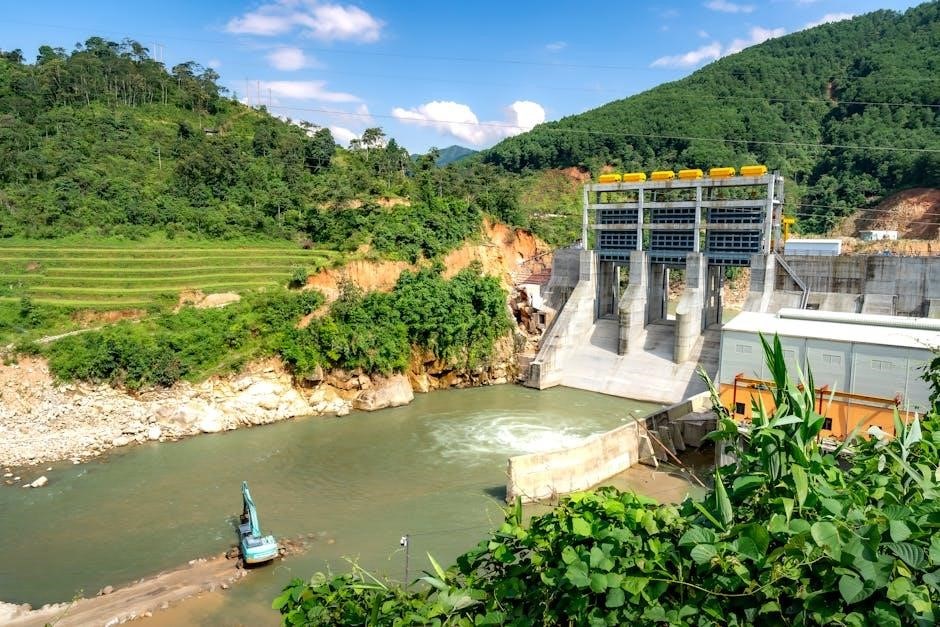Energy flow in ecosystems is the unidirectional transfer of energy from the Sun to producers and through consumers, forming the foundation of ecological processes and interactions.
1.1 Definition and Importance of Energy Flow
Energy flow refers to the transfer of energy through ecosystems, from the Sun to producers and between organisms. It is vital for sustaining life, structuring ecosystems, and maintaining ecological balance. Understanding energy flow is crucial for managing biodiversity, predicting ecosystem responses to changes, and developing conservation strategies to ensure sustainability and resilience in natural systems.
1.2 Overview of Ecosystem Structure and Function
Ecosystems are composed of biotic (living) and abiotic (non-living) components, interacting to form a functional unit. Structure includes producers, consumers, and decomposers, while functions involve energy flow, nutrient cycling, and decomposition. This organization enables ecosystems to maintain balance, support biodiversity, and regulate essential processes, ensuring the survival of organisms and the overall health of the environment.
Mechanisms of Energy Flow in Ecosystems
Mechanisms of energy flow involve photosynthesis, where producers convert sunlight into energy, and consumption through food chains, with energy loss at each trophic level due to the second law of thermodynamics.
2.1 Photosynthesis and Primary Production
Photosynthesis is the cornerstone of energy flow in ecosystems, enabling plants and other producers to convert sunlight into chemical energy stored in organic compounds. This process initiates primary production, forming the base of the food web. Producers synthesize glucose through photosynthesis, storing energy that fuels the entire ecosystem. Herbivores consume this organic matter, transferring energy to higher trophic levels, while some energy is lost as heat or through respiration.
2.2 Energy Transfer Through Food Chains and Food Webs
Energy transfer in ecosystems occurs through food chains and food webs, where producers pass energy to herbivores, and then to carnivores. Only 10% of energy is transferred between trophic levels due to losses as heat and metabolic processes. Food chains represent linear pathways, while food webs depict complex interactions, enhancing ecosystem resilience. This unidirectional flow ensures energy availability at each level, sustaining life and ecological balance.
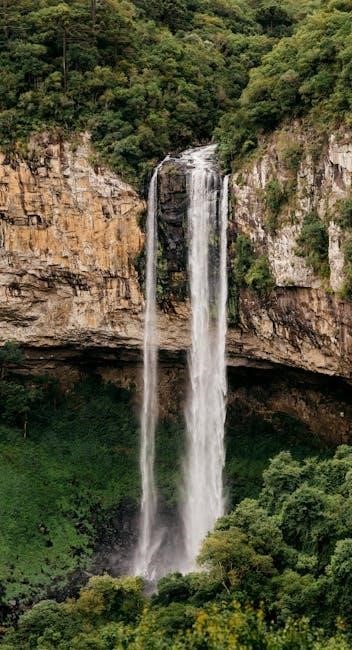
Ecological Pyramids and Energy Distribution
Ecological pyramids represent energy flow, biomass, and population size in ecosystems. They illustrate unidirectional energy transfer, highlighting losses at each trophic level due to metabolic processes and heat dissipation.
3.1 Types of Ecological Pyramids: Energy, Biomass, and Numbers
Energy pyramids show the flow of energy through each trophic level, with each level receiving less energy than the previous one. Biomass pyramids represent the total mass of organisms at each level, while numerical pyramids depict population sizes. These pyramids vary in shape depending on the ecosystem type and environmental conditions, providing insights into the structure and function of different ecosystems.

3.2 Pyramid of Energy: Unidirectional Flow and Losses
The energy pyramid illustrates the unidirectional flow of energy through ecosystems, emphasizing that energy decreases at each trophic level. This reduction, explained by the second law of thermodynamics, results from metabolic processes and heat loss. Only a fraction of energy is transferred to the next level, highlighting the inefficiency inherent in energy flow, which shapes ecosystem dynamics and productivity.
Trophic Levels and Their Roles
Trophic levels define the roles of producers, consumers, and decomposers in energy flow, illustrating how energy is efficiently transferred and transformed within ecosystems.
4.1 Producers: Foundation of the Ecosystem
Producers, such as plants, algae, and cyanobacteria, are the primary organisms that capture sunlight and convert it into chemical energy through photosynthesis; This process forms the base of the food web, providing energy for all other trophic levels. Producers are essential for initiating energy flow in ecosystems, enabling the survival of herbivores, carnivores, and decomposers by storing energy in organic compounds like glucose.
4.2 Consumers: Herbivores, Carnivores, and Decomposers
Consumers, including herbivores, carnivores, and decomposers, play a vital role in energy flow by transferring energy from one trophic level to the next. Herbivores consume producers, while carnivores feed on herbivores or other carnivores. Decomposers break down dead organisms, recycling nutrients and releasing energy back into the ecosystem. This process ensures energy is distributed efficiently, maintaining the balance of the ecosystem’s energy flow and nutrient cycling.
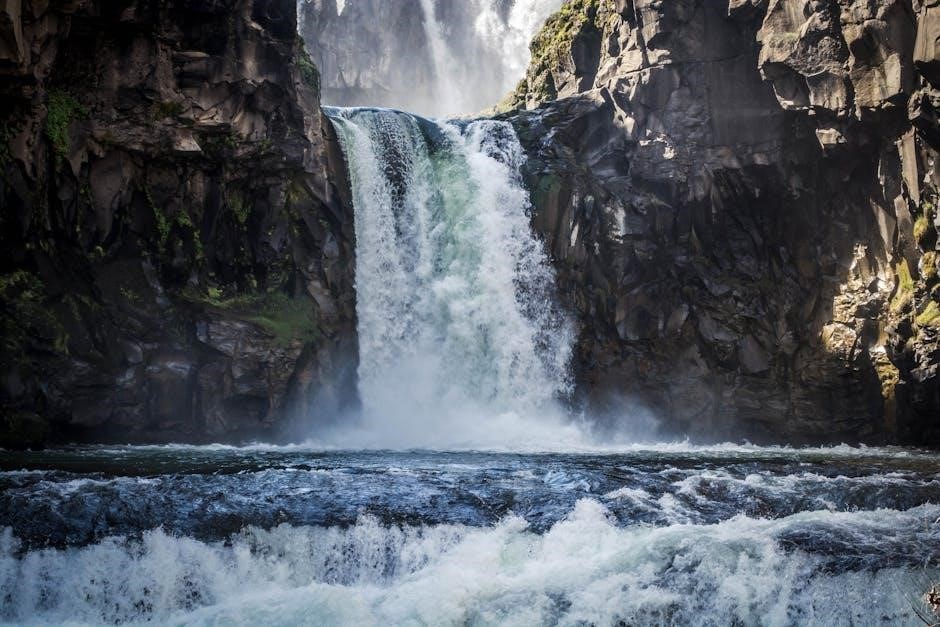
Factors Influencing Energy Flow
Environmental conditions, biodiversity, and ecological processes significantly influence energy flow, affecting its efficiency and limitations within an ecosystem’s structure and function.
5.1 Biodiversity and Species Complexity
Biodiversity and species complexity play a crucial role in energy flow by influencing the efficiency of energy transfer between trophic levels. Diverse ecosystems with complex food webs tend to have more stable energy flows, as multiple pathways allow energy to be distributed among various organisms. Higher biodiversity enhances resilience, ensuring that energy flow remains consistent even when some species are affected by environmental changes or predators. Additionally, species complexity promotes ecological balance, maintaining the integrity of energy distribution across different trophic levels and supporting the overall health of the ecosystem. This intricate network of interactions ensures that energy is utilized optimally, minimizing losses and maximizing the sustainability of the ecosystem. As a result, biodiversity acts as a cornerstone for maintaining efficient and stable energy flow in ecosystems.
5.2 Environmental and Climatic Conditions
Environmental and climatic conditions significantly influence energy flow in ecosystems by affecting photosynthesis, decomposition, and trophic interactions. Factors like temperature, precipitation, and sunlight determine the productivity of producers, which directly impacts energy availability for consumers. For instance, arid ecosystems have limited energy flow due to low plant growth, while tropical rainforests exhibit high energy flow due to abundant sunlight and water. These conditions shape the efficiency of energy transfer and ecosystem resilience, ensuring that energy distribution aligns with environmental constraints and supports biodiversity. Climatic variability can disrupt energy flow, highlighting the importance of stable conditions for maintaining ecological balance and sustaining trophic processes. Thus, environmental and climatic factors are critical in regulating the flow of energy through ecosystems, ensuring their stability and functionality. These elements create a dynamic interplay that determines the overall energy dynamics within an ecosystem, making them indispensable for its survival and productivity.
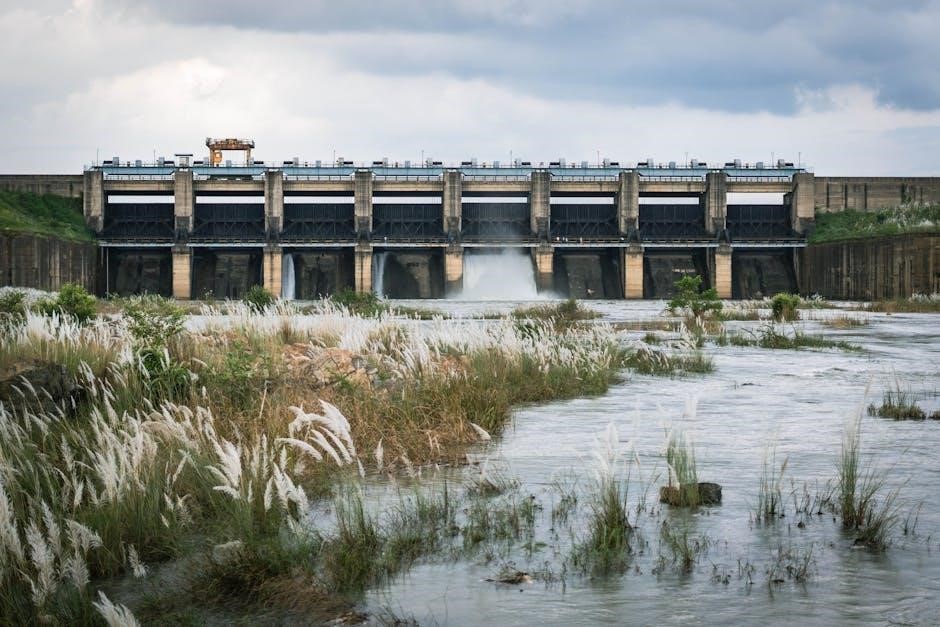
Energy Efficiency and Limitations
Energy efficiency in ecosystems is limited by the second law of thermodynamics, resulting in significant energy loss at each trophic level, reducing overall system productivity and sustainability.
6.1 The Second Law of Thermodynamics and Energy Loss
The second law of thermodynamics governs energy flow in ecosystems, dictating that energy transfer is inefficient. As energy moves through trophic levels, a significant portion is lost as heat, reducing the amount available for subsequent levels. This fundamental principle explains why ecological pyramids are narrow at higher trophic levels, highlighting the inherent limitations of energy flow in sustaining complex ecosystems.
6.2 Ecological Implications of Energy Loss
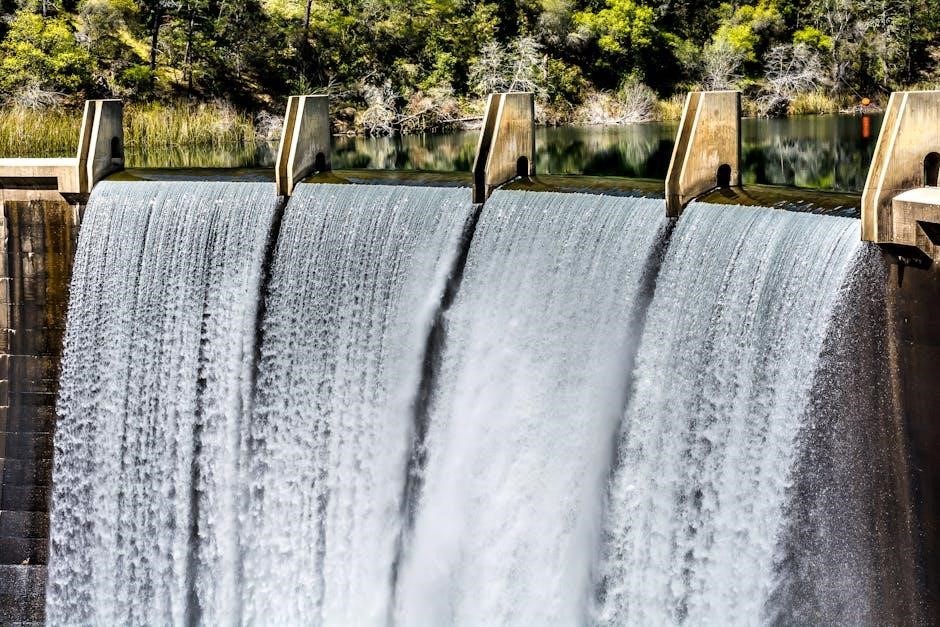
Energy loss at each trophic level limits ecosystem productivity and structure. This inefficiency explains why ecological pyramids narrow upward, with fewer resources available for higher trophic levels. The second law of thermodynamics underscores the inevitability of energy loss, shaping ecosystem dynamics and influencing biodiversity. Understanding these losses is crucial for managing resources sustainably and mitigating human impacts on ecosystems.

Human Impact on Energy Flow
Human activities disrupt ecosystems, altering energy flow through habitat destruction, pollution, and climate change, necessitating conservation strategies to restore balance and sustain biodiversity.
7.1 Anthropogenic Changes in Ecosystems
Anthropogenic changes, such as deforestation, pollution, and climate change, significantly alter ecosystem structures, disrupting energy flow. These activities reduce biodiversity, impair photosynthesis, and destabilize food webs, leading to cascading effects on trophic levels. Human-induced stressors also accelerate energy loss, compromising ecosystem resilience and sustainability, as documented in various energy flow in the ecosystem PDF resources.

7.2 Conservation Strategies for Sustaining Energy Flow
Conservation strategies focus on restoring habitats, reducing pollution, and promoting sustainable practices to maintain energy flow. Protecting biodiversity ensures efficient energy transfer through trophic levels. Efforts like reforestation and wildlife conservation help preserve ecological balance, as outlined in energy flow in the ecosystem PDF resources, ensuring long-term ecosystem health and sustainability.
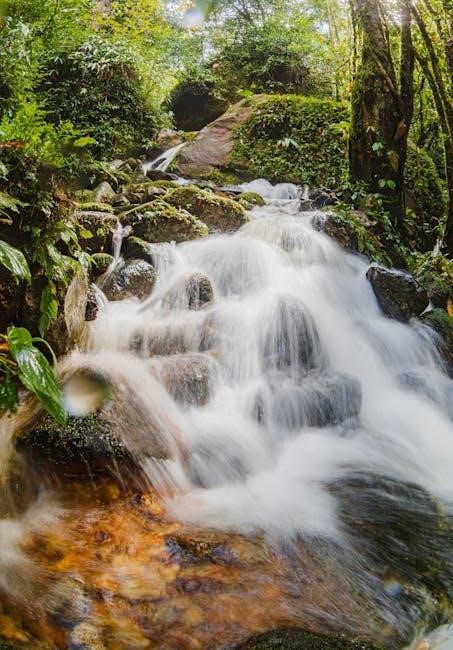
Case Studies and Examples
Case studies reveal how energy flow sustains ecosystems, such as in forests and oceans, supporting biodiversity and trophic systems, as detailed in ecosystem PDFs, highlighting their ecological importance.
8.1 Energy Flow in Forest Ecosystems
Forest ecosystems exemplify energy flow through trophic levels, starting with photosynthesis by trees and undergrowth. This energy is transferred to herbivores like deer and insects, then to predators such as wolves and owls. Decomposers recycle organic matter, maintaining nutrient cycles. PDF resources highlight how forest biodiversity enhances energy efficiency, supporting complex food webs and sustaining ecological balance. This showcases the critical role of forests in energy distribution and ecosystem health.
8.2 Energy Flow in Aquatic Ecosystems
Aquatic ecosystems rely on phytoplankton as primary producers, converting sunlight into energy through photosynthesis. This energy flows through zooplankton, fish, and apex predators, forming complex food webs. Decomposers recycle organic matter, maintaining nutrient cycles. PDF resources emphasize the role of biodiversity in aquatic systems, where energy transfer efficiency supports ecosystem health and sustainability, highlighting the interconnectedness of aquatic life and their environments.

Tools and Resources for Studying Energy Flow
Ecological models, simulations, and PDF resources provide comprehensive insights into energy flow dynamics, offering tools for analyzing trophic interactions and ecosystem functioning effectively and sustainably.
9.1 Ecological Models and Simulations
Ecological models and simulations are powerful tools for understanding energy flow in ecosystems. They mimic interactions between organisms and their environment, allowing researchers to predict and analyze energy dynamics. These models often incorporate trophic levels, nutrient cycling, and environmental factors, providing insights into how energy is transferred and transformed. By simulating ecosystem processes, scientists can better comprehend the complexities of energy flow and its implications for ecosystem sustainability and conservation efforts.
9.2 PDF Resources and Educational Materials
PDF resources and educational materials provide comprehensive insights into energy flow in ecosystems. These include worksheets, Doodle Notes, and textbooks, offering detailed explanations of ecological processes. They cover topics like food chains, ecological pyramids, and energy transfer mechanisms. Many resources are available for download, serving as valuable tools for students and educators to deepen their understanding of energy flow dynamics and ecosystem functioning.
Energy flow is central to ecosystem functioning, sustaining life and interactions. Future research will focus on conservation strategies and ecological models to enhance energy flow understanding and sustainability.
10.1 Summary of Key Concepts
Energy flow in ecosystems is unidirectional, starting with producers and transferring through consumers, with significant losses at each trophic level due to the second law of thermodynamics. Producers, such as plants, form the foundation by converting sunlight into chemical energy via photosynthesis. Consumers, including herbivores and carnivores, rely on this energy, while decomposers recycle nutrients back into the ecosystem. This process powers ecosystem functioning, supports biodiversity, and maintains ecological balance, emphasizing the importance of conservation strategies to sustain energy flow and ecosystem health.
10.2 The Role of Energy Flow in Ecosystem Sustainability
Energy flow is crucial for ecosystem sustainability, powering biological processes and supporting biodiversity. It ensures nutrient cycling and maintains ecological balance. Efficient energy transfer sustains trophic levels, while losses highlight the need for conservation. Human activities, like habitat destruction, disrupt energy flow, emphasizing the importance of preserving natural processes to maintain ecosystem health and resilience for future generations.

